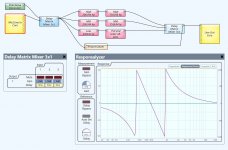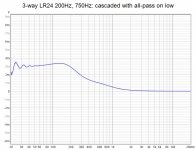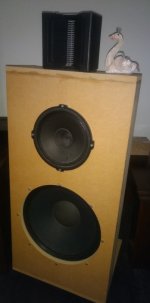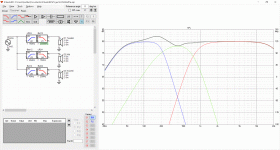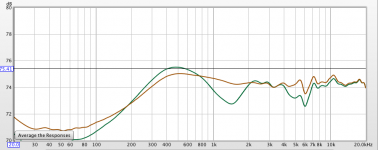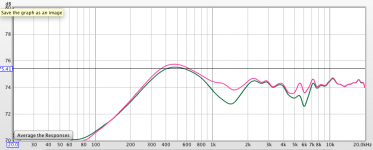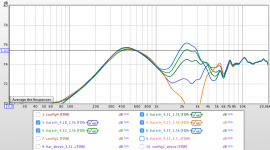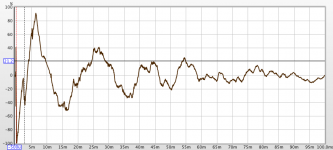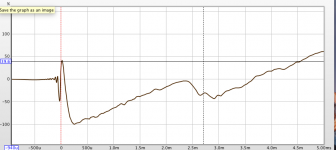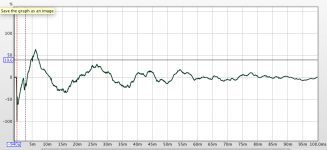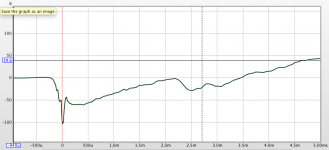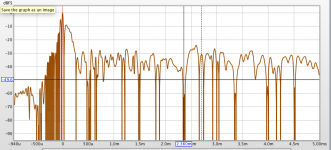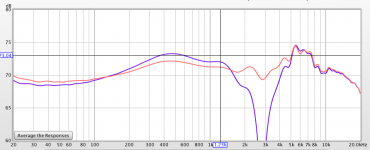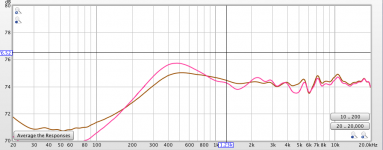Hi BYRTT, sorry..I see the phase traces easy enough.
Oh, when i mouse click inside animations...nothing happens????
So I was studying the 4 examples you posted in #772.
Gonna learn something about IIR yet
I'm not sure why you included the BW12 40Hz high-passes, or the BW12 20kHz low passes.
But it appears that somehow they work in conjunction with a cascading strategy to effect something akin to the all-pass filter Linkwitz says is needed with his cascading recommendation. Woofer crossover & offset
I took the 4th order panel, your second one, and built the Linkwitz recommendation, using cascading with an all-pass on the low.
Schematic which includes mag and phase transfer function is below,
and a group delay measurement from REW.
IF the purpose of the BW12 40Hz high-passes, or the BW12 20kHz low passes you used was in fact for making a synthetic all-pass, wouldn't it be better to just use an all-pass?
As there would be no low and high rolloffs, and better group delay.
But like i say, really just guessing what your purpose was...
thx
Oh, when i mouse click inside animations...nothing happens????
So I was studying the 4 examples you posted in #772.
Gonna learn something about IIR yet
I'm not sure why you included the BW12 40Hz high-passes, or the BW12 20kHz low passes.
But it appears that somehow they work in conjunction with a cascading strategy to effect something akin to the all-pass filter Linkwitz says is needed with his cascading recommendation. Woofer crossover & offset
I took the 4th order panel, your second one, and built the Linkwitz recommendation, using cascading with an all-pass on the low.
Schematic which includes mag and phase transfer function is below,
and a group delay measurement from REW.
IF the purpose of the BW12 40Hz high-passes, or the BW12 20kHz low passes you used was in fact for making a synthetic all-pass, wouldn't it be better to just use an all-pass?
As there would be no low and high rolloffs, and better group delay.
But like i say, really just guessing what your purpose was...
thx
Attachments
My understanding is use BW4 for every lowpass, bessel2 for every high pass.
Each higher section needs to be delayed by 1/2 period of its fc, and delays need to add cummutavly.
I keep going by 2-way instructions in post #1 and multi-way in #724.
If these are in err, someone will let us know I guess...
Whoops! At same point in time I must have swapped BW4 for LR4...
I use two times Q0.71 now (Linkwitz-Riley 4th order), but should have used Q0.54 followed by Q1.31 (Butterworth 4th order)...
Fedde
I just did an attempt to simulate my filters and compare the effects of LR4 vs BW4. Interestingly I got different results as BYRTT. I use 2500 us delay for mid and 3167 us delay for tweeter in the driver configuration tab.
@BYRT:
Is there any configuration I may be missing? Could you maybe share your project file for comparison?
Hereby my simulation results:
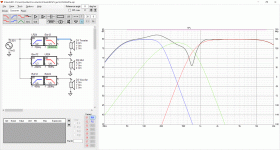
Fedde
@BYRT:
Is there any configuration I may be missing? Could you maybe share your project file for comparison?

Hereby my simulation results:

Fedde
I just did an attempt to simulate my filters and compare the effects of LR4 vs BW4. Interestingly I got different results as BYRTT. I use 2500 us delay for mid and 3167 us delay for tweeter in the driver configuration tab.
@BYRT:
Is there any configuration I may be missing? Could you maybe share your project file for comparison?
Hereby my simulation results:
View attachment 868843
Fedde
Hi Fedde,
Unless you don't want to use the classic Harsch, try this:
On tweeter:
Change LR24 hp to Bes12, remove But12 lp, keep 3.167ms delay.
On mid:
Change Bes12 hp freq to 200Hz, change LR24 lp to But24 lp, keep 2.5ms delay
On woofer: remove But12 hp.
it will look like my post #766...
Hi Fedde,
Unless you don't want to use the classic Harsch, try this:
On tweeter:
Change LR24 hp to Bes12, remove But12 lp, keep 3.167ms delay.
On mid:
Change Bes12 hp freq to 200Hz, change LR24 lp to But24 lp, keep 2.5ms delay
On woofer: remove But12 hp.
it will look like my post #766...
The problem is that I cannot use my tweeter at this crossover point in 2nd order Bessel. 750 Hz 4th order is already quite low for an Heil AMT. Though I could try 1500 Hz 2nd order or so...
Anyhow, I can and will continue with my simulations now to compare some design alternatives... I also feel that BW4, BS12, BW4, BS12 sounds more logical than BW4, BS12, BS12, BW4...
Fedde
This VituixCAD is really handy for some quick simulations! 
I compared the approach from post1 vs post724. The simulation of post1 approach looks quite like my measurements. I think it is obvious which approach is the more accurate...
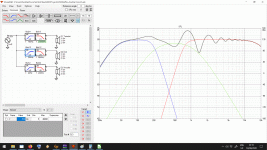
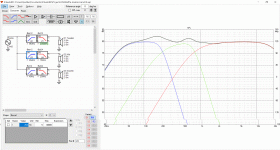
So it appears I will need to cross my tweeter higher and use this newer scheme...
Tomorrow I will try to do some more simulations to apply the recommendations of BYRTT regarding sidebands etc. and see what this brings for double Harsch XO...
Fedde

I compared the approach from post1 vs post724. The simulation of post1 approach looks quite like my measurements. I think it is obvious which approach is the more accurate...


So it appears I will need to cross my tweeter higher and use this newer scheme...
Tomorrow I will try to do some more simulations to apply the recommendations of BYRTT regarding sidebands etc. and see what this brings for double Harsch XO...
Fedde
Dear folks,
In the meantime I did a ton of simulations to try various scenarios. So far, I did not find a configuration that can do Harsch XO like behavior by having BES2 on left side and BW4 on right side of crossovers. I would need to go deeper into the math to understand why.
So in the end, I made a configuration with two stacked normal Harsch XO with crossovers at 200 and 1500 Hz. This works well in the simulation (acceptable phase shift and ripple IMHO):
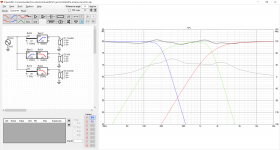
I already tried it out in my plate amps, but I still need to validate this by measurements and listening tests...
Fedde
In the meantime I did a ton of simulations to try various scenarios. So far, I did not find a configuration that can do Harsch XO like behavior by having BES2 on left side and BW4 on right side of crossovers. I would need to go deeper into the math to understand why.
So in the end, I made a configuration with two stacked normal Harsch XO with crossovers at 200 and 1500 Hz. This works well in the simulation (acceptable phase shift and ripple IMHO):

I already tried it out in my plate amps, but I still need to validate this by measurements and listening tests...
Fedde
Add delay to the tweeter and the mid, around 2.8ms and 2.5ms and tweak from there  moreover, you have to measure your speakers, these have to be acoustic slopes so you might have to use some other filters to achieve. The delays affect greatly the vertical polars as well as the slopes do and both should be pretty much spot on for your speaker for best results. Have fun!
moreover, you have to measure your speakers, these have to be acoustic slopes so you might have to use some other filters to achieve. The delays affect greatly the vertical polars as well as the slopes do and both should be pretty much spot on for your speaker for best results. Have fun! 
Sure I have the delays set, otherwise it would not work. I have made the drivers flat one or two octaves after crossover, so I would presume the acoustical curve is right. But I could double check indeed. Still it is a pity I need to cross higher, I can quite hear the difference in speed between AMT and bicone mid. I need to try a faster mid, probably an 18 sounds 6 incher...
Jordan JX92S, Vifa XT19, MLTL, S. Harsch crossover
Hi all,
Amazing thread - 5 years and almost 800 posts. Quite an accomplishment
I wanted to share my own results from using S. Harsch, get some feedback if possible and also share my own listening impressions.
I write this with one day to go before my 50th birthday, which makes me relatively old (certainly as far as my ears go) though not necessarily experienced.
The design started here:
Tweeter to match JX92S
Updated recently to use minDSP (nano) as a lockdown project.
Help with Diffraction Peak
The Harsch variation was a Sunday afternoon project, so I didn't take a full set of measurements but just aimed to evaluate the approach and see whether it made sense to take it further.
Approach
- 1m measurements on-axis (listening height) and about 45 degrees above-axis
- Drivers equalised to be flat over a reasonable bandwidth using REW optimiser (the tweeter has a series cap for protection, so the equaliser has to do some extra work to compensate for the rolloff). All miniDSP PEQs.
- Tweeter: 2nd order Bessel
- Midbass: 4th order butterworth, both dialed-in using miniDSP
- Crossover 2.5kHz (also tried 3kHz)
- Compensation tweeter delay of half a wavelength
- Crossover ripples post-equalised with 2x PEQs in the input-chain (again using the magic REW filter optimiser). I ummed and arred as to whether this might impact the phase response, but I don't think it should, since the effect of the Harsch crossover which is handling time/phase alignment of the individual drivers, can be considered separately from the input path. Would be interested to get people's views on this one.
- Measure again
- Listen
I've always have measurement issues below 1kHz (wooden floor, strong reflections, so quite a short measurement window), so the baffle-step compensation is hand (ear)- tuned.
Comparisons to LR4 @ 2kHz and LR8 @1.8kHz
Results to follow.
Hi all,
Amazing thread - 5 years and almost 800 posts. Quite an accomplishment
I wanted to share my own results from using S. Harsch, get some feedback if possible and also share my own listening impressions.
I write this with one day to go before my 50th birthday, which makes me relatively old (certainly as far as my ears go) though not necessarily experienced.
The design started here:
Tweeter to match JX92S
Updated recently to use minDSP (nano) as a lockdown project.
Help with Diffraction Peak
The Harsch variation was a Sunday afternoon project, so I didn't take a full set of measurements but just aimed to evaluate the approach and see whether it made sense to take it further.
Approach
- 1m measurements on-axis (listening height) and about 45 degrees above-axis
- Drivers equalised to be flat over a reasonable bandwidth using REW optimiser (the tweeter has a series cap for protection, so the equaliser has to do some extra work to compensate for the rolloff). All miniDSP PEQs.
- Tweeter: 2nd order Bessel
- Midbass: 4th order butterworth, both dialed-in using miniDSP
- Crossover 2.5kHz (also tried 3kHz)
- Compensation tweeter delay of half a wavelength
- Crossover ripples post-equalised with 2x PEQs in the input-chain (again using the magic REW filter optimiser). I ummed and arred as to whether this might impact the phase response, but I don't think it should, since the effect of the Harsch crossover which is handling time/phase alignment of the individual drivers, can be considered separately from the input path. Would be interested to get people's views on this one.
- Measure again
- Listen
I've always have measurement issues below 1kHz (wooden floor, strong reflections, so quite a short measurement window), so the baffle-step compensation is hand (ear)- tuned.
Comparisons to LR4 @ 2kHz and LR8 @1.8kHz
Results to follow.
But actually I was very very pleasantly surprised.
Here are some of my subjective impressions of Harsch, compared to LR4
Listening conditions:
- 3m from speaker, in the sweet-spot (correct listening height and in centre)
- speakers toed-in to cross about 1m in front of listener
Listening impressions
- transient attack is much better. It comes across as more snap, which makes the sound brighter, but not in a bad way. For example, the brightness does not affect the vocals too much and I'm fairly sure it is my brain interpreting the better transient response. This is the case with most recordings.
- acoustic instruments sound much more visceral and identifyable. This is particularly the case with older recordings (e.g. intro to Rolling Stones Honky Tonk Woman cowbell sounds like a cowbell in the room). But also e.g. Eric Clapton's unplugged Old Love - the steel string guitar solo sound like a real acoustic guitar with steel strings, placed in the room
- the various instruments in the recording mix are better separated and it's now easy to hear the timbre and recording techniques of the individual instruments. For example some previously bright or harsh recordings are now revealed to just have a bright vocal, but the rest of the mix is fine. To put it another way, I can now hear the individual effects applied to the individual instruments, rather than just hearing the mix as a whole.
- on the negative side, the speakers are "harder" sounding, slightly less gentle on the ears. Although the instrument separation is better than LR4, sometimes they are lower down in the soundstage (closer to the floor). I'm wondering if this is because of floor-bounce. I did not take a below axis measurement, but I expect a peak to complement the above axis null.
One thing I'm surprised about is that the above-axis frequency response null is not very audible on most recordings, when standing up. So even though the power response is measurably inferior with Harsch, compared to LR4, the tradeoff in my particular case is well worth it. My ceilings are high - almost 4m, so possibly the reflection hits too late to make a big difference.
I'm not even 100% sure all the improvements are due to the better time-phase alignment. The room interaction is complex and I may just have hit on a better design for the room.
Would be great to get your feedback. I'll leave the 800th post to you
Here are some of my subjective impressions of Harsch, compared to LR4
Listening conditions:
- 3m from speaker, in the sweet-spot (correct listening height and in centre)
- speakers toed-in to cross about 1m in front of listener
Listening impressions
- transient attack is much better. It comes across as more snap, which makes the sound brighter, but not in a bad way. For example, the brightness does not affect the vocals too much and I'm fairly sure it is my brain interpreting the better transient response. This is the case with most recordings.
- acoustic instruments sound much more visceral and identifyable. This is particularly the case with older recordings (e.g. intro to Rolling Stones Honky Tonk Woman cowbell sounds like a cowbell in the room). But also e.g. Eric Clapton's unplugged Old Love - the steel string guitar solo sound like a real acoustic guitar with steel strings, placed in the room
- the various instruments in the recording mix are better separated and it's now easy to hear the timbre and recording techniques of the individual instruments. For example some previously bright or harsh recordings are now revealed to just have a bright vocal, but the rest of the mix is fine. To put it another way, I can now hear the individual effects applied to the individual instruments, rather than just hearing the mix as a whole.
- on the negative side, the speakers are "harder" sounding, slightly less gentle on the ears. Although the instrument separation is better than LR4, sometimes they are lower down in the soundstage (closer to the floor). I'm wondering if this is because of floor-bounce. I did not take a below axis measurement, but I expect a peak to complement the above axis null.
One thing I'm surprised about is that the above-axis frequency response null is not very audible on most recordings, when standing up. So even though the power response is measurably inferior with Harsch, compared to LR4, the tradeoff in my particular case is well worth it. My ceilings are high - almost 4m, so possibly the reflection hits too late to make a big difference.
I'm not even 100% sure all the improvements are due to the better time-phase alignment. The room interaction is complex and I may just have hit on a better design for the room.
Would be great to get your feedback. I'll leave the 800th post to you
Last edited:
Hi AntM,
Thanks for trying this and sharing so much info. You have some deep dips and I am not sure if it’s inherent in the speaker / driver or the crossover. Can you show what the raw woofer and tweeter response looks like, no EQ? In your step response I see a second broad peak 2.5ms later and that might just be a reflection.
Also try to show a measured XO response with contributions from each driver and the sum:
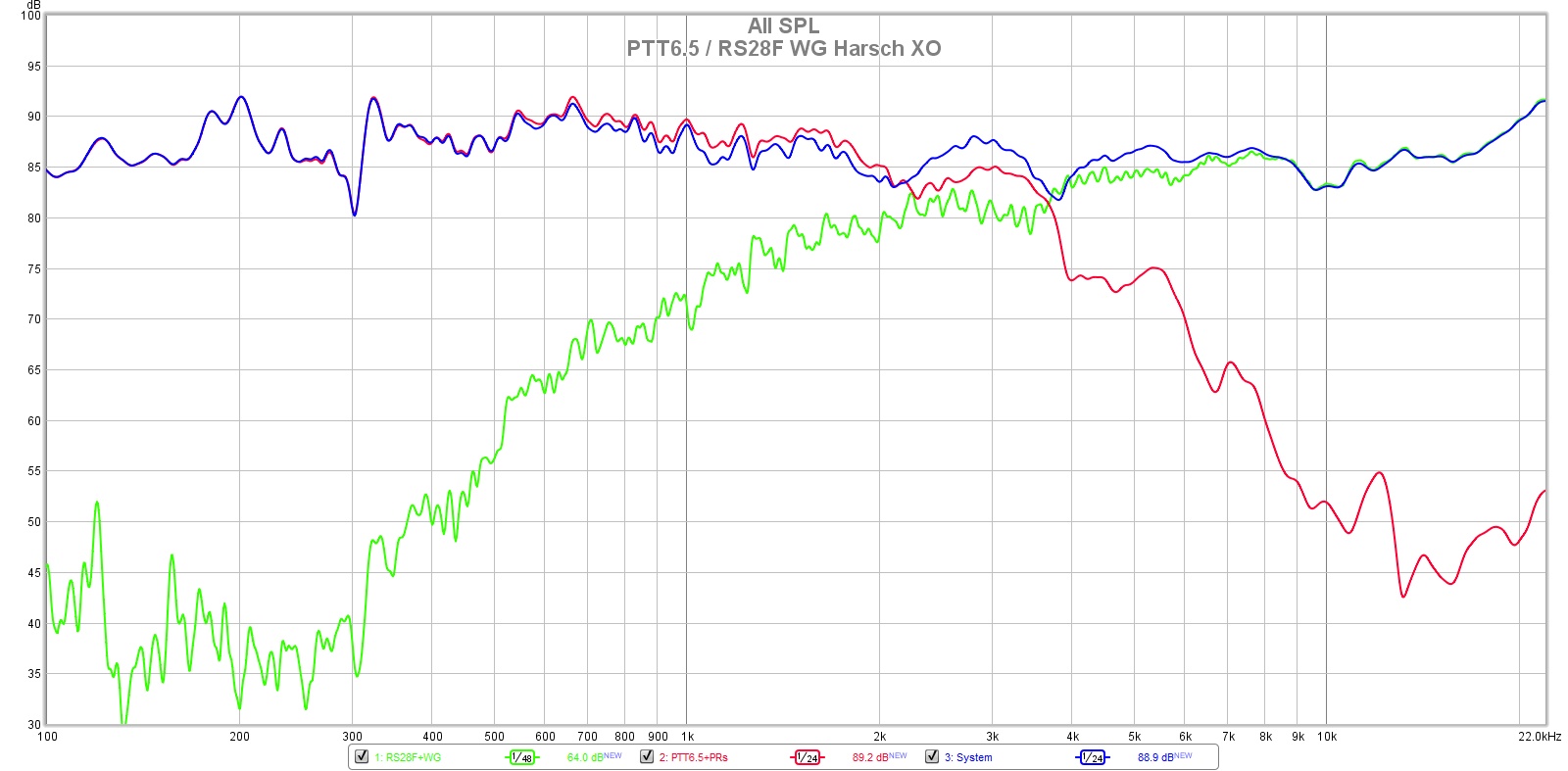
Another thing to try is to measure at 0.5m away with speaker and mic axis 1m high above floor. Then use FDW gating at 6 cycles. This will ensure that you are looking at the intrinsic speaker response and not floor or wall reflections.
You should do all your measurements this way as that is the only way to remove the floor bounce. Your mic looks like it has inverted phase or your amp is inverted. I have found the UMIK to be phase inverted.
Thanks for trying this and sharing so much info. You have some deep dips and I am not sure if it’s inherent in the speaker / driver or the crossover. Can you show what the raw woofer and tweeter response looks like, no EQ? In your step response I see a second broad peak 2.5ms later and that might just be a reflection.
Also try to show a measured XO response with contributions from each driver and the sum:
Another thing to try is to measure at 0.5m away with speaker and mic axis 1m high above floor. Then use FDW gating at 6 cycles. This will ensure that you are looking at the intrinsic speaker response and not floor or wall reflections.
You should do all your measurements this way as that is the only way to remove the floor bounce. Your mic looks like it has inverted phase or your amp is inverted. I have found the UMIK to be phase inverted.
Last edited:
- Home
- Loudspeakers
- Multi-Way
- S. Harsch XO
